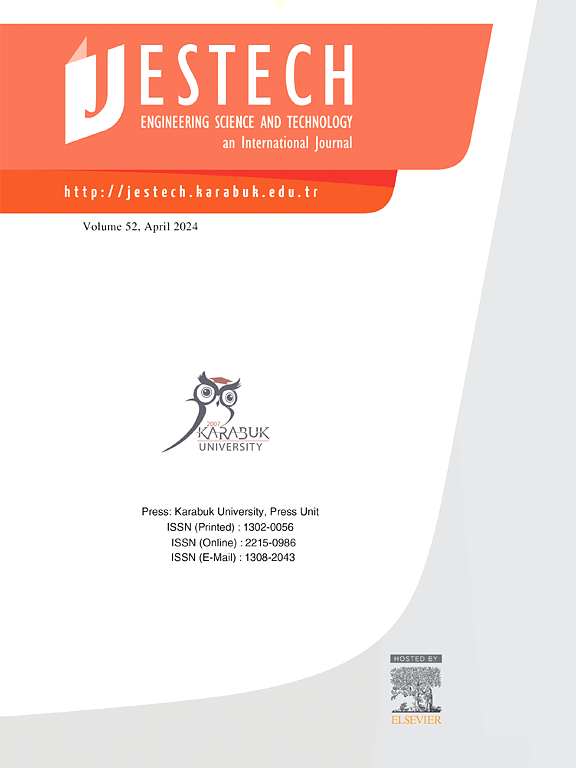Numerical prediction of strength and temperature changes within cemented paste backfill considering barricade stability
IF 5.1
2区 工程技术
Q1 ENGINEERING, MULTIDISCIPLINARY
Engineering Science and Technology-An International Journal-Jestech
Pub Date : 2025-02-01
DOI:10.1016/j.jestch.2025.101966
引用次数: 0
Abstract
Manufacturing an intended recipe of tails, binder and water, cemented paste backfill (CPB) is employed to refill the cavities created in underground mining operations. To ensure that it remains stable and forms a solid structure, filling slurry must be supported by a rigid barricade at the bottom of the mining area. Fill structures’ process is guided via coupled thermal/hydraulic/mechanical/chemical developments, which can directly affect the stability of barricade. Hence, it is essential to study the pressure changes and distribution within the barricade. A fully coupled THMC numerical model was established in the current study in order to predict mechanical features and temperature changes inside CPB, and to measure effect of these changes on barricade’s stability. Predictive outcomes obtained from the model built were compared with the results of a field experiment, showing good consistency and thus proving model’s validity in mimicking evolution of temperature change and its effect on strength features of barricade in the course of backfill hydration. The verified multi-physical field model was used to numerically study the change of lateral pressure of barricade under different working conditions. The results show that properly increasing the initial temperature of CPB and increasing the distance between the barricade and the stope can effectively alleviate the lateral pressure on the barricade. The consequences of the existent research could offer a vital guideline on the topic of backfill barricade’s stability analysis.
求助全文
约1分钟内获得全文
求助全文
来源期刊

Engineering Science and Technology-An International Journal-Jestech
Materials Science-Electronic, Optical and Magnetic Materials
CiteScore
11.20
自引率
3.50%
发文量
153
审稿时长
22 days
期刊介绍:
Engineering Science and Technology, an International Journal (JESTECH) (formerly Technology), a peer-reviewed quarterly engineering journal, publishes both theoretical and experimental high quality papers of permanent interest, not previously published in journals, in the field of engineering and applied science which aims to promote the theory and practice of technology and engineering. In addition to peer-reviewed original research papers, the Editorial Board welcomes original research reports, state-of-the-art reviews and communications in the broadly defined field of engineering science and technology.
The scope of JESTECH includes a wide spectrum of subjects including:
-Electrical/Electronics and Computer Engineering (Biomedical Engineering and Instrumentation; Coding, Cryptography, and Information Protection; Communications, Networks, Mobile Computing and Distributed Systems; Compilers and Operating Systems; Computer Architecture, Parallel Processing, and Dependability; Computer Vision and Robotics; Control Theory; Electromagnetic Waves, Microwave Techniques and Antennas; Embedded Systems; Integrated Circuits, VLSI Design, Testing, and CAD; Microelectromechanical Systems; Microelectronics, and Electronic Devices and Circuits; Power, Energy and Energy Conversion Systems; Signal, Image, and Speech Processing)
-Mechanical and Civil Engineering (Automotive Technologies; Biomechanics; Construction Materials; Design and Manufacturing; Dynamics and Control; Energy Generation, Utilization, Conversion, and Storage; Fluid Mechanics and Hydraulics; Heat and Mass Transfer; Micro-Nano Sciences; Renewable and Sustainable Energy Technologies; Robotics and Mechatronics; Solid Mechanics and Structure; Thermal Sciences)
-Metallurgical and Materials Engineering (Advanced Materials Science; Biomaterials; Ceramic and Inorgnanic Materials; Electronic-Magnetic Materials; Energy and Environment; Materials Characterizastion; Metallurgy; Polymers and Nanocomposites)
 求助内容:
求助内容: 应助结果提醒方式:
应助结果提醒方式:


